Effects of Game-Based Instruction on the Results of Primary School Children Taking a Natural Science Course
Abstract
:1. Introduction
1.1. Background and Motive
1.2. Research Purpose
2. Literature Review
2.1. Incorporation of Scenario Simulation into Game-Based Instruction
2.2. Game-Based Digital Learning: Effect of Gender
2.3. Research Questions
3. Research Method
3.1. Adjusting the Content of the Game-Based Instruction
3.2. Participants
- (1)
- The participants were fifth graders aged between 10 and 11 years and recruited from an elementary school in Taoyuan, Taiwan. Students from two regular classes were recruited, with one class of 30 students (14 female and 16 male students) being designated as the experimental group. The students’ knowledge and learning comprehension were assessed overall and at the group level. Lin and Lin [31] stated that the purpose of classifying students into two groups is to gain an in-depth understanding of learning outcomes; with the selecting conditions of experimenting classes, we chose two classes that had relative similarities in the average GPA of last semester, numbers of each class, the ratio of male and female students, and the range of ages. As for the individual scores for both two classes, the average score division was comparatively even, which showed no extremely high or low grades scored in each class. Therefore, the error for the experiment would be kept to the minimum. In addition, the time that students spend on the smart phones or computer games was evaluated in selection conditions. For both two experimenting classes, students would spend at least around one hour on their phones and computers, which includes the time for using computers in their classes per day. All the above selecting conditions are based on the most common situations for elementary students. Thus, our participants were further put into the following groups to analyze the learning outcomes of the game-based instruction:
- Experimental and control group: Using game-based instruction and an e-textbook, respectively.
- Score groups (60–79 and 80–100): Some students comprehend text more slowly, so to better understand the learning improvement rate of the groups receiving different sets of learning materials, the students were classified according to their pre-test scores. The pre-test cutoff score for grouping was determined after discussions with teachers. Semester scores over the previous 3 years were averaged; typically, the semester score of a fifth grader is between 80 and 95. Among the few students with an average semester score of less than 80, most demonstrated low willingness to learn and/or slowness in comprehending text.
- Gender groups: This study also explored gender differences in learning outcomes using game-based instruction.
3.3. Research Tools
- Game-based instruction on the topic of carbon footprint:The team expects to design the game teaching material similar to the video game modes that students used to play; thus, we applied 3D, MAX, MAYA, and Cinema 4D software in the game development. The mode of game menu we developed is same as the chatting box commonly present in smart phones and computer games. In that case, students would have quick response to the game, which saves time for familiarising themselves with the game menu.
- Official e-textbook on the topic of carbon footprint.
- Pre- and post-test: The pre-test focused on government-promoted carbon reduction and environmental protection strategies, with the aim of assessing the basic carbon footprint knowledge of the two groups. The post-test focused entirely on the concept of the carbon footprint, assessing the knowledge acquired by the two groups receiving different types of game-based instruction.
3.4. Procedure
3.5. Measures
- The independent variable was the type of course material (game-based instruction versus e-textbook). The structure and content of the game-based instruction were based on elementary school science and living technology courses. Specifically, visual (animations, videos, graphics, and word cards) and auditory (sounds, dialogue, music, and positive verbal feedback) elements, together with scenario simulations, were integrated into the materials, and science-based demonstration videos featuring virtual characters were used to enable the experimental group to acquire knowledge.
- The dependent variable was the learning outcomes of the students in the experimental and control groups.
- The control variables were as follows:
- The content of the game-based instruction was consistent with that of the official textbook used in schools. During the content selection and design of the game-based instruction, a group of teachers (science teachers, class advisors, and the Director of Curriculum) were invited to assist in content adjustment and editing.
- The students were recruited only from regular classes; however, they were further classified into average/high- and low-score groups.
4. Results
4.1. Paired-Samples t-Test
4.1.1. Overall Learning Outcomes of the Experimental and Control Groups Regarding Carbon Footprint Knowledge
4.1.2. Differences in Learning Outcomes Between the Low- and Average/High-Score Groups
4.2. Results of Paired-Samples and Independent-Samples t-Tests and ANCOVA
4.2.1. Gender Differences in Learning Outcomes
5. Discussion
6. Conclusions
Author Contributions
Funding
Conflicts of Interest
References
- Hong, J.C.; Chan, C.H. Game Performance in Covariation Reasoning: The Correlates Between Gameplay Self-Efficacy, and Metacognition Reflected Gameplay Anxiety and Gameplay Interest. J. Res. Educ. Sci. 2018, 63, 131–162. [Google Scholar]
- National Academy for Educational Research. The Trend and Development of e-Textbook in Junior High School and Primary School; Development Center for Textbooks, National Academy for Educational Research: Taipei, Taiwan, 2013. [Google Scholar]
- Li, T.W. The trend and development of electronic textbooks. J. Textbook Res. 2009, 2, 111–140. [Google Scholar]
- Chen, P.C. New trend of electronic textbooks. Educ. Mon. 2010, 516, 36–40. [Google Scholar]
- Chen, D.W. The opportunity and problems of school textbooks supply system. Taiwan Educ. Rev. 2015, 4, 19–22. [Google Scholar]
- Hong, J.C.; Cheng, C.L.; Hwang, M.Y.; Lee, C.K.; Chang, H.Y. Assessing the educational values of digital games. J. Comput. Assist. Learn. 2009, 25, 423–437. [Google Scholar] [CrossRef]
- Hlodan, O. Digital games: Learning through play. Bioscience 2008, 58, 791–805. [Google Scholar] [CrossRef]
- Tsai, F.H.; Yu, K.C.; Hsiao, H.S. Discovering the value of digital game-based learning from the new perspective of transfer. Curric. Instr. Q. 2008, 11, 237–278. [Google Scholar]
- Burguillo, J.C. Using game theory and competition-based learning to stimulate student motivation and performance. Comput. Educ. 2010, 55, 566–575. [Google Scholar]
- Dickey, M.D. Murder on Grimm Isle: The impact of game narrative design in an educational game-based learning environment. Br. J. Educ. Technol. 2011, 42, 456–469. [Google Scholar] [CrossRef]
- Selfe, C.L.; Hawisher, G.E.; Van Ittersum, D.; Gee, J.P. Gaming Lives in the Twenty-First Century; Palgrave Macmillan: New York, NY, USA, 2016; 273p. [Google Scholar]
- Kron, F.W.; Gjerde, C.L.; Sen, A.; Fetters, M.D. Medical student attitudes toward video games and related new media technologies in medical education. BMC Med. Educ. 2010, 10, 50. [Google Scholar] [CrossRef]
- Guralnick, M.J. International perspectives on early intervention: A search for common ground. J. Early Interv. 2008, 30, 90–101. [Google Scholar] [CrossRef]
- Kao, W.J. Context simulation strategy of the global warming and carbon reduction in teaching materials design and development. Living Technol. Educ. J. 2011, 44, 42–51. [Google Scholar]
- Lin, L.; Atkinson, R.K.; Savenye, W.C.; Nelson, B.C. Effects of visual cues and self-explanation prompts: Empirical evidence in a multimedia environment. Interact. Learn. Environ. 2016, 24, 799–813. [Google Scholar] [CrossRef]
- Lai, C.F.; Chang, C.S. Design and development of online course using scenario-based strategy in teacher education program for classroom management course. J. Educ. Media Libr. Sci. 2005, 42, 433–449. [Google Scholar]
- Hsieh, P.S. The Design of Scenario-Based e-Learning Course. Ph.D. Thesis, National Taiwan Normal University, Taipei, Taiwan, 2005. [Google Scholar]
- Garris, R.; Ahlers, R.; Driskell, J.E. Games, motivation, and learning: A research and practice model. Simul. Gaming 2002, 33, 441–467. [Google Scholar] [CrossRef]
- Yu, K.C.; Hsiao, H.S.; Tsai, F.H. A study of using online role-playing game to support web-based learning. J. Comput. Sci. Appl. 2006, 2, 119–128. [Google Scholar]
- Hsiao, H.C. A brief review of digital games and learning. In Proceedings of the First IEEE International Workshop on Digital Game and Intelligent Toy Enhanced Learning, Jhongli, Taiwan, 18–19 May 2007; pp. 124–129. [Google Scholar]
- Tsai, C.F.; Chen, R.M. Multimedia game-based disaster prevention learning for the visually impaired. In Proceedings of the 13rd Annual Meeting of the Ergonomics Society of Taiwan and Conference, I-Shou University, Kaohsiung, Taiwan, 4 March 2006. [Google Scholar]
- Tsai, C.F.; Chen, R.M. Multimedia game-based disaster prevention learning for the visually impaired. J. Comput. Sci. Appl. 2008, 4, 143–160. [Google Scholar]
- Rosas, R.; Nussbaum, M.; Cumsille, P.; Marianov, V.; Correa, M.; Flores, P.; Salinas, M. Beyond nintendo: Design and assessment of educational video games for first and second grade students. Comput. Educ. 2003, 40, 71–94. [Google Scholar] [CrossRef]
- Robertson, J.; Howells, C. Computer games design: Opportunities for successful learning. Comput. Educ. 2008, 50, 559–578. [Google Scholar] [CrossRef]
- Liu, C.C.; Cheng, Y.B.; Huang, C.W. The effect of simulation games on the learning of computational problem solving. Comput. Educ. 2011, 57, 1907–1918. [Google Scholar] [CrossRef]
- Conati, C. Probabilistic assessment of user’s emotions in educational games. J. Appl. Artif. Intel. 2002, 16, 555–575. [Google Scholar] [CrossRef]
- Sardone, N.B.; Devlin-Scherer, R. Teacher candidates’ views of digital games as learning devices. Issues Teach. Educ. 2009, 18, 47–67. [Google Scholar]
- Ebner, M.; Holzinger, A. Successful implementation of user-centered game based learning in higher education: An example from civil engineering. Comput. Educ. 2007, 49, 873–890. [Google Scholar] [CrossRef]
- Fengfeng, K. Alternative goal structures for computer game-based learning. Int. J. Comp. Support. Collab. Learn. 2008, 3, 429–445. [Google Scholar]
- Meimaris, M. Computer games-based learning: Research and initiatives. In Proceedings of the 3rd International Conference on Digital Interactive Media in Entertainment and Arts, New York, NY, USA, 10 September 2008; p. xviii. [Google Scholar]
- Mazurek, M.O.; Engelhardt, C.R. Video game use in boys with autism spectrum disorder, ADHD, or typical development. Pediatrics 2013, 132, 260–266. [Google Scholar] [CrossRef]
- Mitchell, A.; Savill-Smith, C. The Use of Computer Games for Learning: A Review of the Literature; Learning and Skills Development Agency: London, UK, 2004. [Google Scholar]
- Lin, M.S.; Lin, S.L. The effects of an interactive multimedia sexuality learning program on the sexual knowledge of high school level students with intellectural disabilities at a special education school. Spec. Educ. Q. 2013, 126, 17–33. [Google Scholar]
- Lin, D.W. The research in art games of serious games. J. Cult. Creat. Ind. Res. 2012, 2, 67–84. [Google Scholar]
- Rollings, A.; Adams, E. On Game Design; New Riders: Indianapolis, IN, USA, 2003. [Google Scholar]
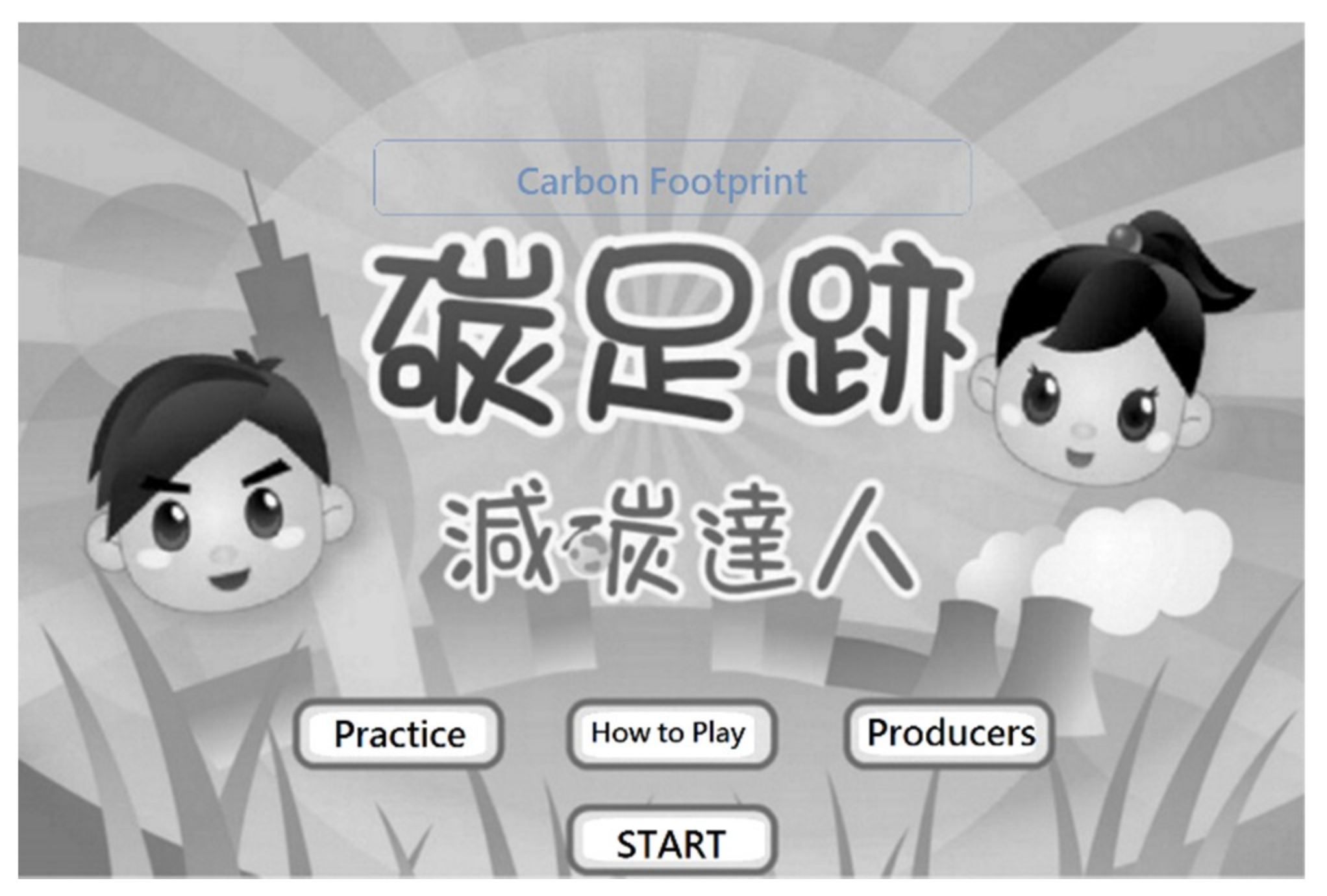
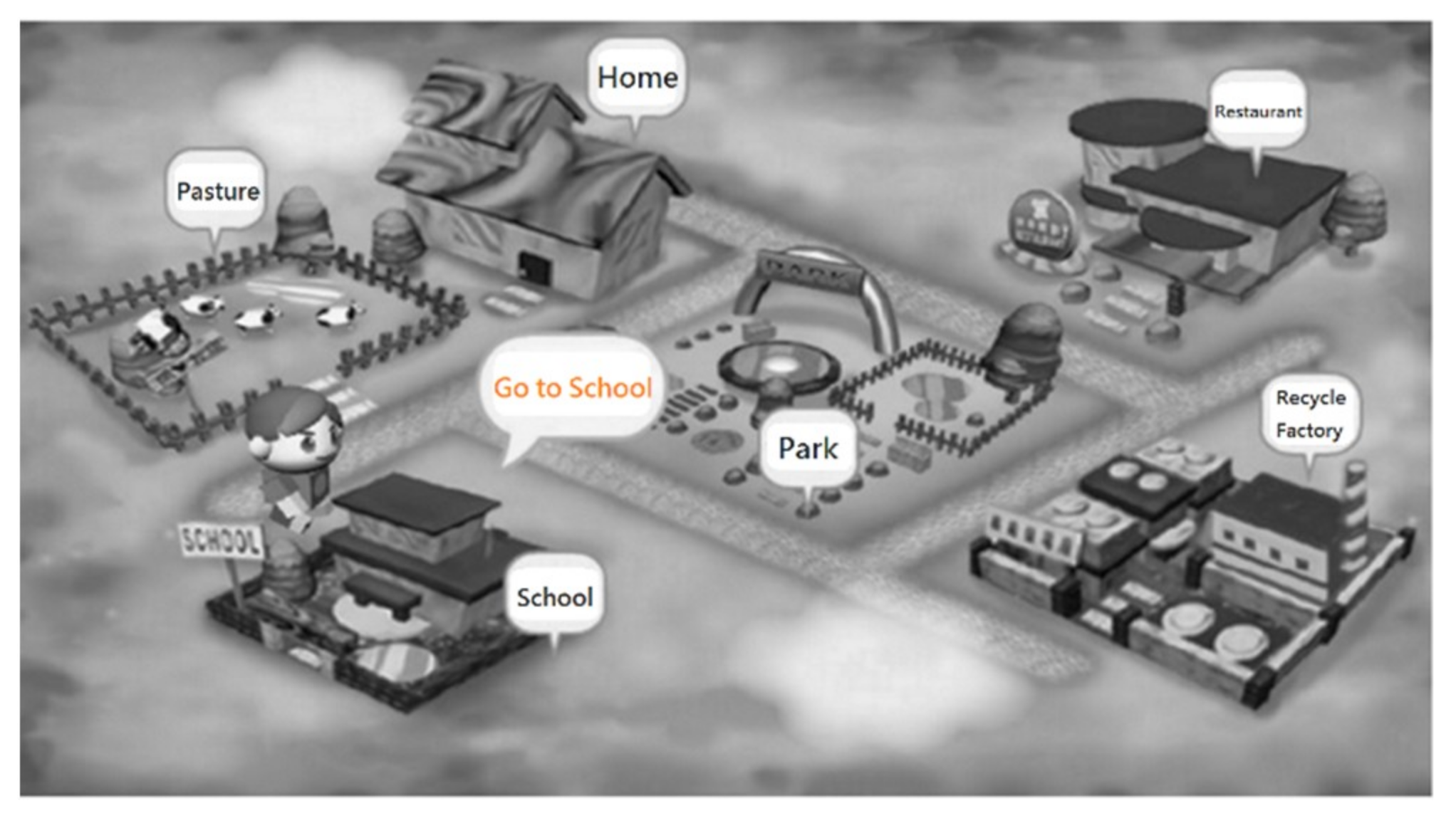
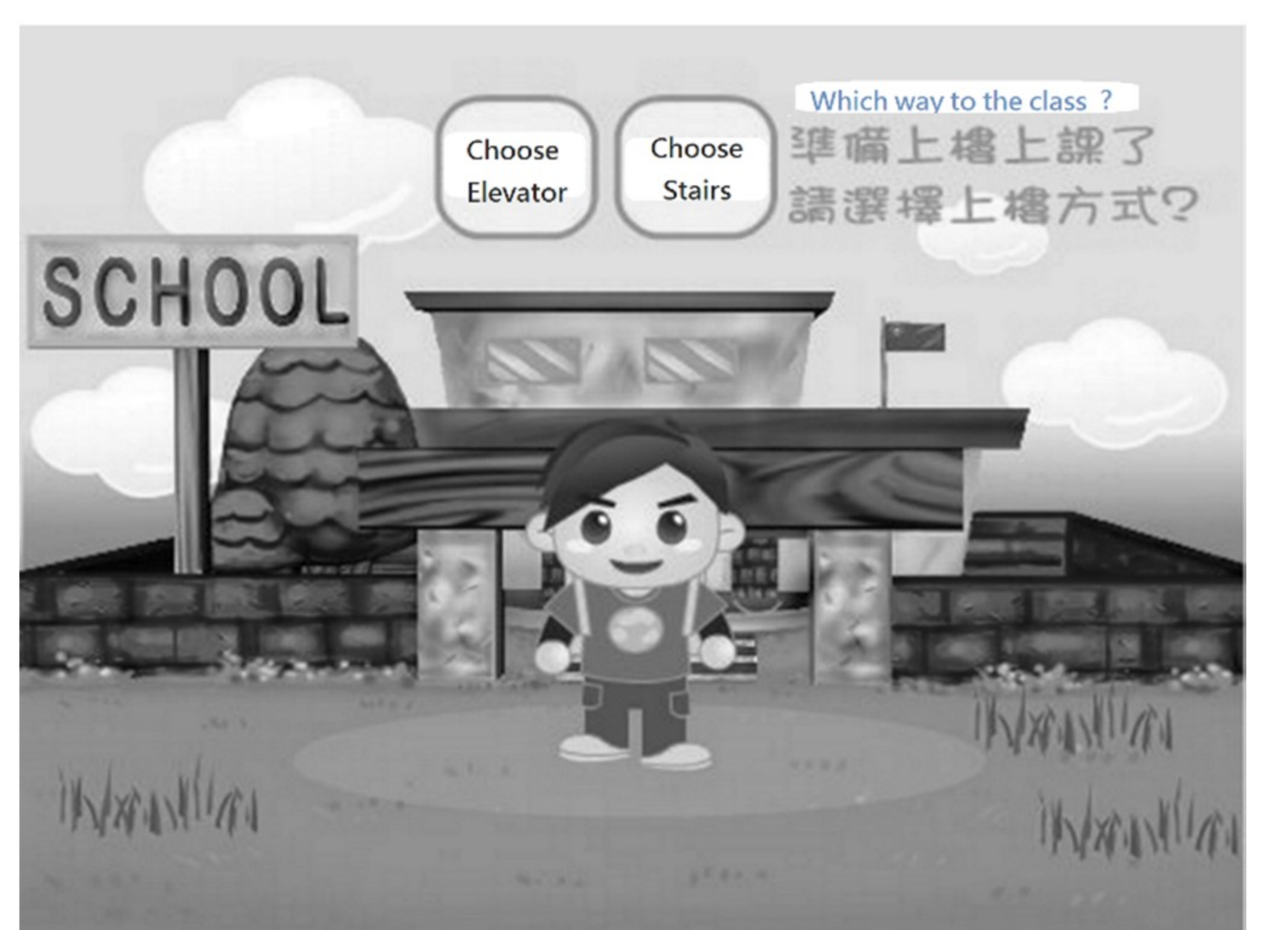
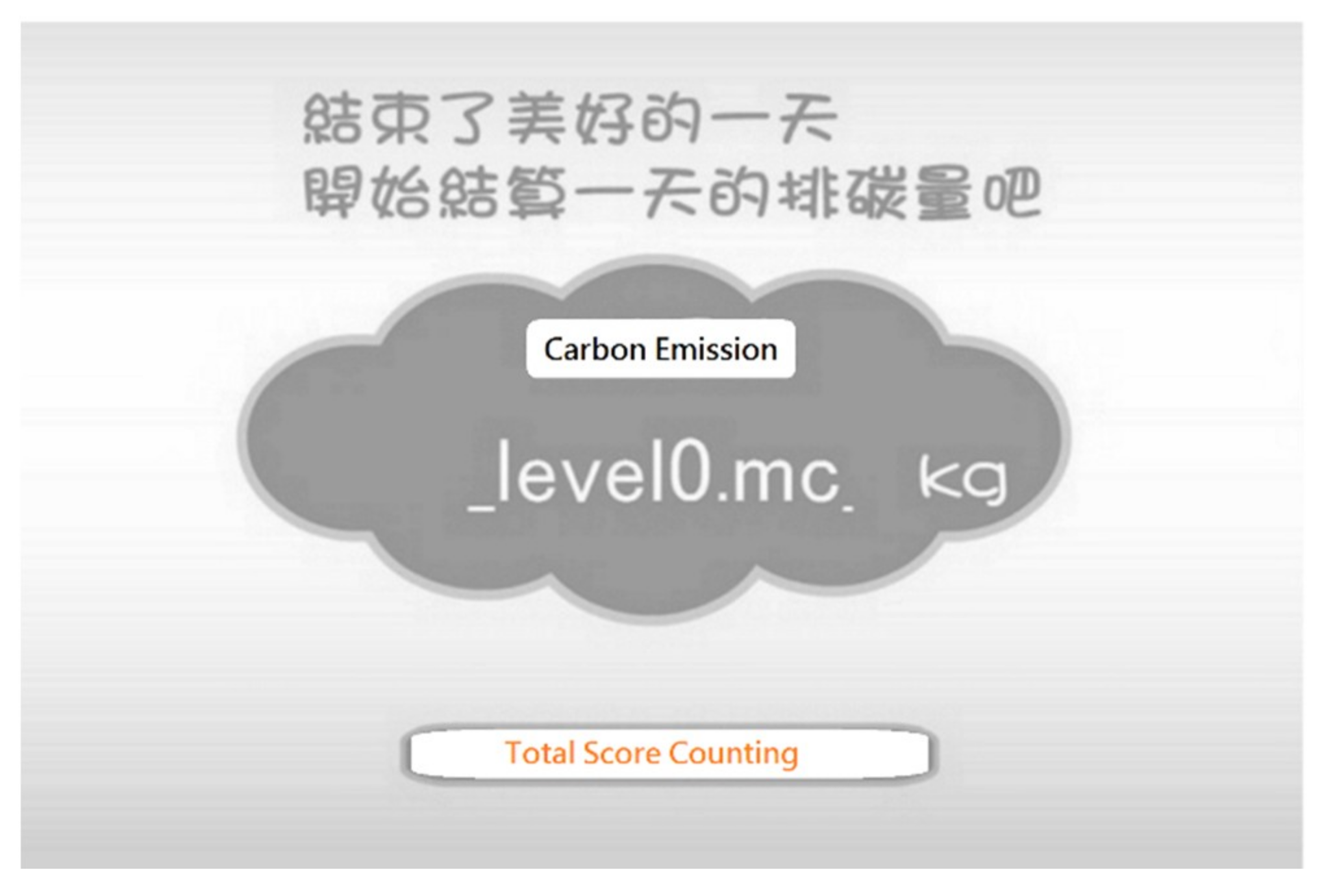
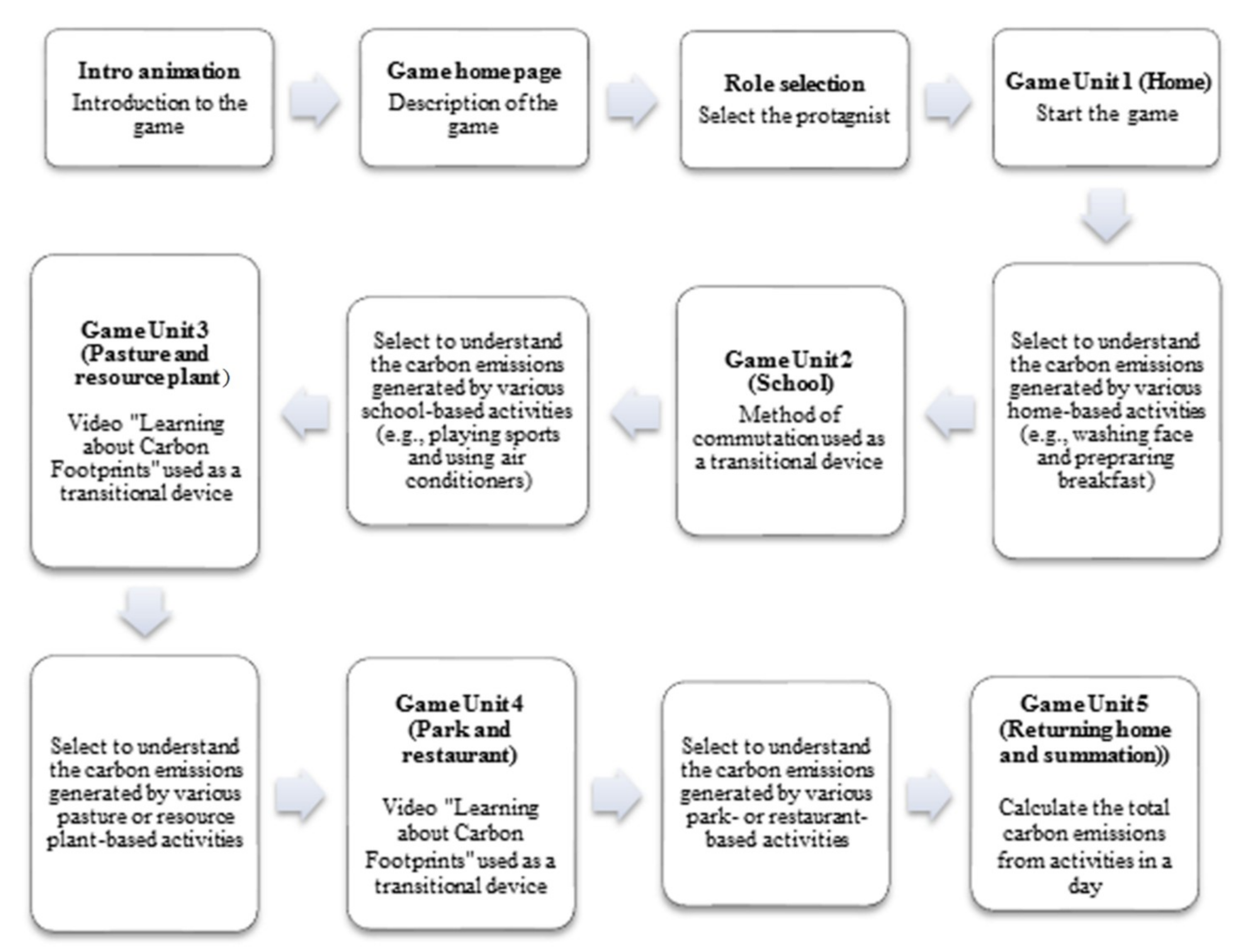
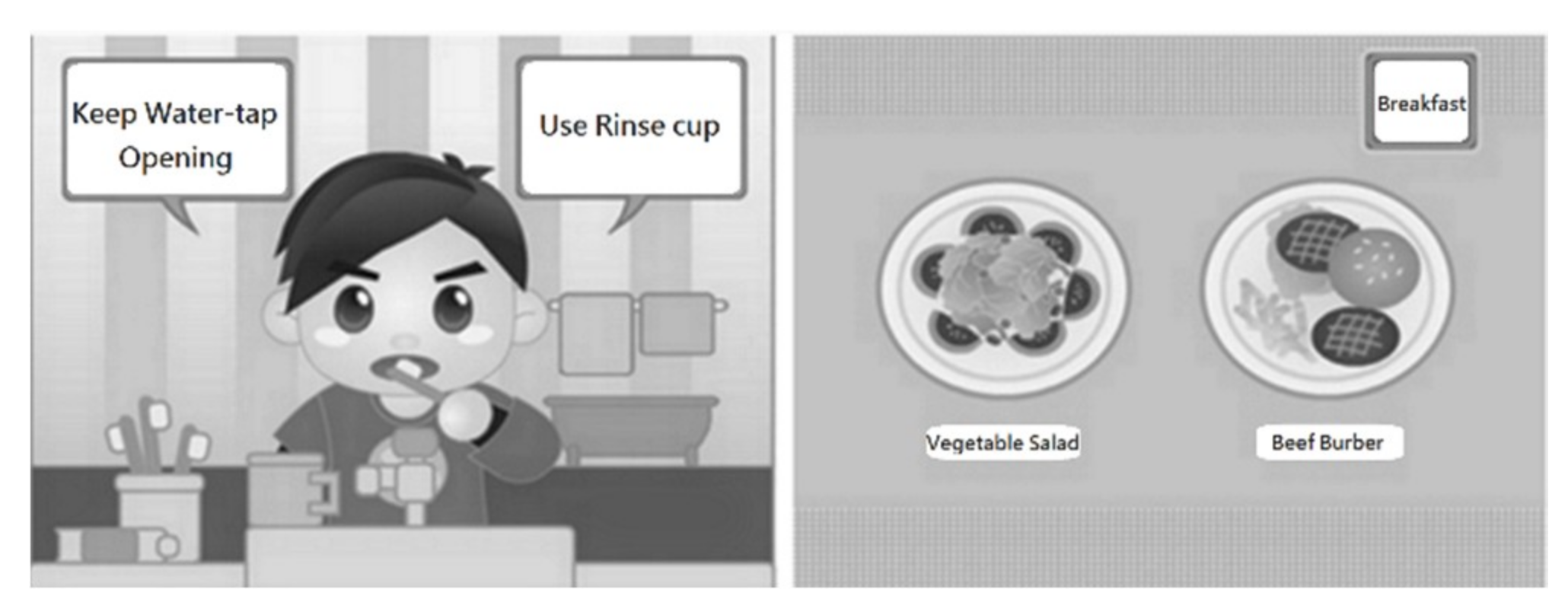
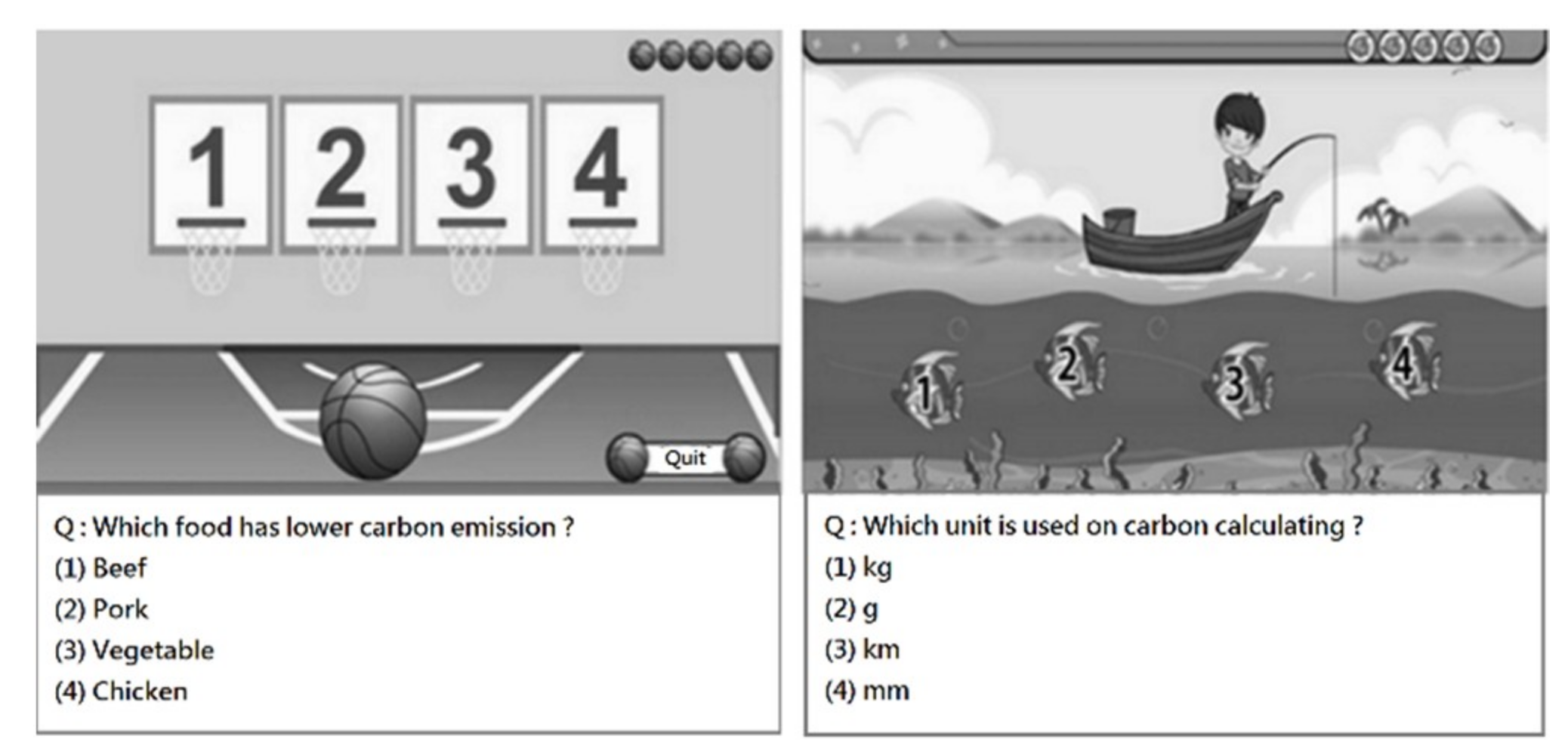
| Group | Number of Students | Pre-Test Score | Post-Test Score | Difference Between Pre- and Post-Test Score | t Statistic | ||
|---|---|---|---|---|---|---|---|
| Avg. | SD. | Avg. | SD. | ||||
| Control group (e-textbook) | 30 | 80.8 | 3.88 | 84.3 | 12.51 | +3.5 | −1.559 |
| Experimental group (game-based instruction) | 30 | 79.8 | 12.12 | 86.8 | 11.77 | +7.0 | −5.221 *** |
| Group | Number of Students | Pre-Test Score | Post-Test Score | Difference Between Pre- And Post-Test Score | t Statistic | ||
|---|---|---|---|---|---|---|---|
| Avg. | SD. | Avg. | SD. | ||||
| 60–79 score group | 14 | 69.14 | 7.98 | 79.64 | 13.07 | +10.5 | −4.89 *** |
| 80–100 score group | 16 | 89.12 | 5.51 | 93.90 | 5.41 | +4.8 | −3.0 ** |
| Group | Number of Students | Pre-Test | Post-Test | Difference Between Pre- and Post-Test Score | t Statistic | ||
|---|---|---|---|---|---|---|---|
| Avg. | SD. | Avg. | SD. | ||||
| 60–79 score group | 9 | 73.33 | 6.67 | 77.34 | 7.14 | +4.01 | −3.539 ** |
| 80–100 score group | 21 | 89.34 | 4.49 | 90.43 | 8.89 | +1.09 | −0.636 |
| Group | Number of Students | Pre-Test | Post-Test | Difference Between Pre- and Post-Test Score | t Statistic | ||
|---|---|---|---|---|---|---|---|
| Avg. | SD. | Avg. | SD. | ||||
| Males | 16 | 82.13 | 12.44 | 89.63 | 12.33 | +7.5 | −4.01 ** |
| Females | 14 | 77.14 | 11.63 | 83.64 | 10.63 | +6.5 | −3.24 ** |
| Group | Number of Students | Pre-Test | Post-Test | Difference Between Pre- and Post-Test Score | t Statistic | ||
|---|---|---|---|---|---|---|---|
| Avg. | SD. | Avg. | SD. | ||||
| Males | 13 | 79.54 | 5.3 | 85.23 | 10.73 | +5.69 | −2.98 |
| Females | 17 | 81.76 | 1.79 | 83.53 | 14.11 | +1.77 | −0.53 |
© 2019 by the authors. Licensee MDPI, Basel, Switzerland. This article is an open access article distributed under the terms and conditions of the Creative Commons Attribution (CC BY) license (http://creativecommons.org/licenses/by/4.0/).
Share and Cite
Chen, M.-H.M.; Tsai, S.-T.; Chang, C.-C. Effects of Game-Based Instruction on the Results of Primary School Children Taking a Natural Science Course. Educ. Sci. 2019, 9, 79. https://doi.org/10.3390/educsci9020079
Chen M-HM, Tsai S-T, Chang C-C. Effects of Game-Based Instruction on the Results of Primary School Children Taking a Natural Science Course. Education Sciences. 2019; 9(2):79. https://doi.org/10.3390/educsci9020079
Chicago/Turabian StyleChen, Ming-Hsiu Mia, Shih-Ting Tsai, and Chi-Cheng Chang. 2019. "Effects of Game-Based Instruction on the Results of Primary School Children Taking a Natural Science Course" Education Sciences 9, no. 2: 79. https://doi.org/10.3390/educsci9020079
APA StyleChen, M.-H. M., Tsai, S.-T., & Chang, C.-C. (2019). Effects of Game-Based Instruction on the Results of Primary School Children Taking a Natural Science Course. Education Sciences, 9(2), 79. https://doi.org/10.3390/educsci9020079




